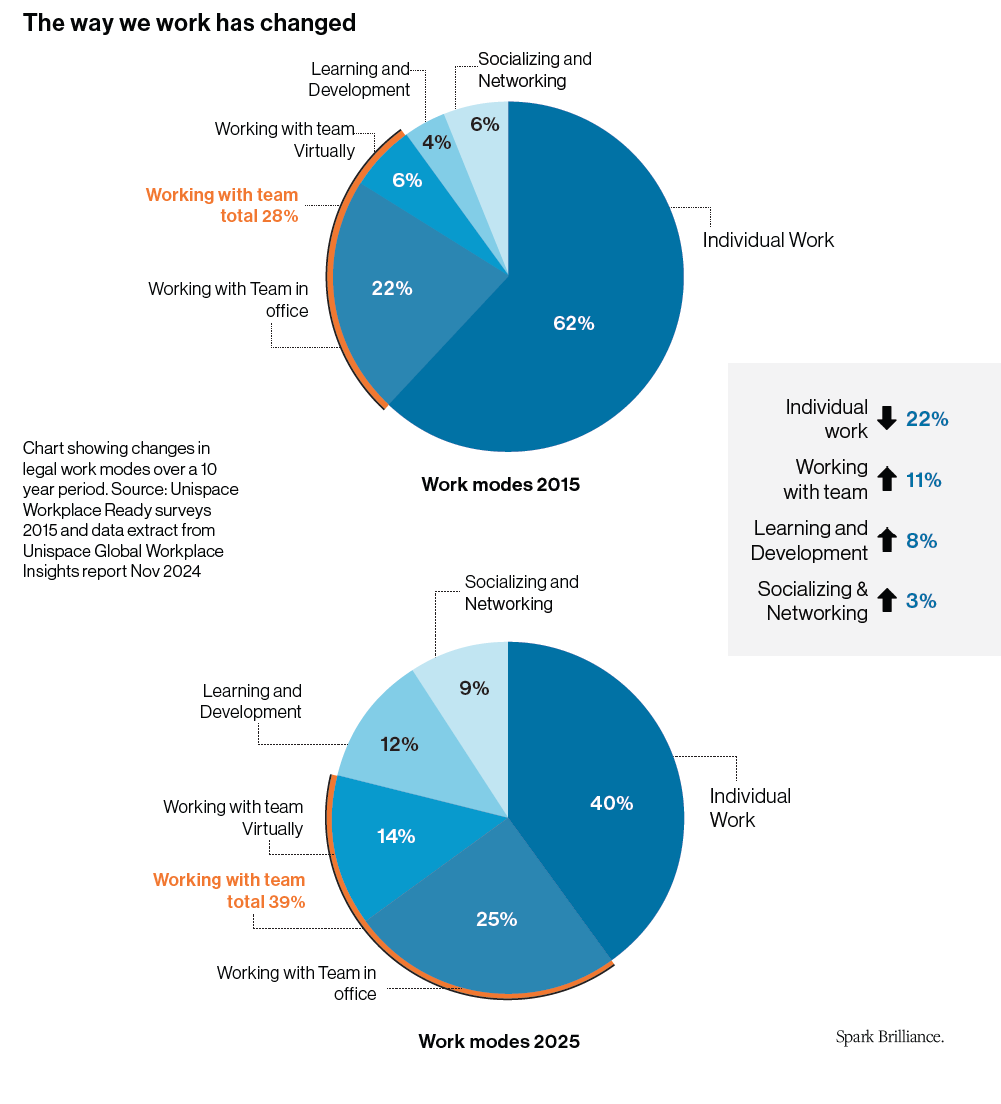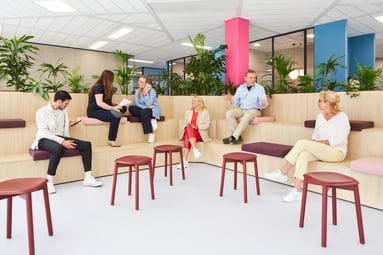Threshold Series | Individual work to team work – 10 years of evolution.
By Simon Pole, Unispace Group Chief Product Officer
Over the past 10 years of collecting and analysing data for the legal sector, I have finally arrived at the moment when we can confidently and quantifiably announce that the way lawyers and attorneys work has changed in a way that should directly affect the workplaces in which they spend their day.
During the past decade, I’ve travelled the globe meeting with law firms that are confronting a common turning point—usually triggered by a lease expiry, a relocation, or a post-pandemic rethink.
These moments require firms to make a decision that will shape how they operate for the next decade: How should we work? And what kind of real estate strategy and workplace do we need to support that?
It’s no secret that law firms are often cautious adopters of change. As the saying goes, lawyers like to “race to be second.” So, when the announcement of a new office hits the Partner’s meeting agenda, it’s rarely met with a cheer. But here’s the reality: the work has changed. And ignoring that shift now carries real risk to performance, talent retention, and long-term competitiveness.
The shift: from solo to collaborative legal work
Ten years ago, our data showed that lawyers spent around 62% of their time on individual, focused work, with only 28% spent collaborating with colleagues. That ratio largely justified the prevalence of private, enclosed offices as the dominant law firm workplace model.
Today, that balance has fundamentally shifted. Across firms, regions, and practice groups, lawyers now spend roughly 40% of their time on individual work and 39% collaborating with their team. That is a near-equal split. And it is not a passing trend—it’s the new normal.

So what’s driving this?
- Clients expect faster, more integrated service.
- Matters are increasingly complex, requiring input from multiple disciplines.
- Technology enables constant coordination across locations and time zones.
- Learning and mentoring, especially for younger lawyers, happens most effectively through real-time collaboration.
Simply put, legal work is no longer dominated by solitary deep-focus. It is more team-based, more dynamic, and more reliant on knowledge sharing than ever before.
What’s getting in the way of change?
Despite this shift, many law firms continue to operate in spaces optimised for how they worked a decade ago.
There are a few reasons for this that I hear during my workshops and interviews:
- Tradition and cultural expectations – The private office is still seen in many firms as a marker of seniority, status, or professionalism. It is also seen as a recruitment tool and reward mechanism reflective of past traditions.
- Concerns about confidentiality – Certain practice groups understandably require spaces where sensitive conversations can happen behind closed doors.
- The personality of the profession – Law often attracts high-concentration, low-interruption workstyles. For many lawyers, focus time is deeply ingrained in their daily rhythm. This extends to specialist and expensive physical acoustic separation.
- Partner fragmentation – Decisions about space are often decentralised or politically charged, especially in large firms with multiple practice leaders and influence rated by billings.
These concerns are valid and on a recent trip to the US to speak at the ALA Annual Conference, a senior Operations Administrator of a mid-sized multinational firm said “its easier to sail on calm seas than it is against the waves.” But sometimes effort should not override the opportunity—and in many cases, the need—to adapt the workplace model to better reflect how people actually work today.
Practice area and leadership style: The two major influences
From years of working with firms around the world, I’ve found that two main factors determine how legal teams actually behave within a space:
- The team’s area of legal practice.
- The leadership style of the Partner or Partners running the team.
Some practice areas may require slightly different work configurations—like insurance litigation when compared to family or employment law—but have surprisingly consistent workflows across firms and jurisdictions. Their team structures, case timelines, and work rhythms are fairly predictable within their area of expertise. While there are always local and cultural nuances, these are not significant enough to warrant entirely different workplace strategies for each office or location.
Where variation really appears is in leadership style. A Partner’s personal philosophy on mentoring, delegation, supervision, and flexibility strongly influences how their team operates. This has become even more apparent in the hybrid work era, where some Partners embrace flexibility while others quietly (or overtly) reassert old norms. This is the topic of another article.
So the challenge is this: How can a workplace support both standardised practice needs and the variability of individual leadership? The answer is not to lock into one rigid model, but to design flexibility into the system—physically and culturally. As we now know, the universal single-sized office was a progressive step from the very traditional four sized status models, however it still doesn’t satisfy the recent insights of increased collaborative team work.
How junior lawyers work and learn has fundamentally shifted
One of the most significant—but often under-acknowledged —changes in law firms over the past decade has been the evolution in how young lawyers work, learn, and develop professionally. This shift is not just about Gen Z or Millennials preferring flexibility—it’s about a broader transformation in how knowledge flows within the modern law firm.
Traditionally, junior lawyers worked in a more linear, hierarchical learning model: instructions came from the Partner; the work was completed individually; feedback was given when time permitted. Like most firms, development was heavily reliant on direct access to senior lawyers—a system that often made learning episodic, inconsistent, and overly dependent on availability. As an example, while working with a large firm in London and understanding team efficiencies, we reviewed the associates’ timesheets and saw the acronym WWP. This represented time waiting for their Partner to review their work or give instructions. For this particular firm the average was 29 minutes a day with the highest recorded for the month was 1hr and 3 minutes. As you can imagine these chargeable units soon add up.
Today, that model is being reshaped by three interrelated factors:
- Digital collaboration tools – Junior lawyers are now more likely to work inside shared documents, team chats, and collaborative platforms where real-time input is possible without waiting for formal feedback loops. This supports faster iterations and distributed mentoring while using AI to review, check and analyse documents.
- Peer-to-peer learning – With flatter team structures and more project-based work, young lawyers increasingly turn to colleagues at similar levels for guidance, precedent, and problem-solving. Learning is faster, more social, and more immediate.
- Changing expectations – Newer generations value autonomy, responsiveness, and transparency. They are used to instant information access in all areas of life and are less inclined to “wait their turn” for feedback. They seek environments that facilitate on-demand coaching and visibility. Access to Partners is often a key consideration during the recruitment process.
The result? An environment that supports informal, embedded, and collaborative learning is no longer a nice-to-have. It’s a competitive advantage in both performance and talent retention. And that environment is shaped— significantly—by how the workplace is designed.
Why should firms consider changing their workplace?
Let’s be clear: changing the workplace doesn’t mean chasing fads or sacrificing focus. It means aligning your environment with the firm’s evolving business reality. Here are four compelling reasons why firms must reconsider their approach:
- Lawyers now work differently – The balance of solo vs. collaborative work has shifted dramatically. Designing your next office around outdated proportions is like buying a suit two sizes too small—inevitably uncomfortable and poorly performing.
- Younger talent demands exposure – Law remains a mentorship-driven profession. When junior lawyers spend more time collaborating, they learn faster, integrate better, and build confidence. A workplace that supports informal interaction accelerates this process—and helps build the next generation of firm leadership.
- Real estate must earn its value – If space is being underused or misused, it becomes a cost centre instead of a value driver. Your real estate should be a high-performance asset—designed not only for productivity but also for culture, learning, and growth. While this is certainly not the sentiment from my experience in the UK, Australia or New Zealand, but a recent comment from a large US multi-office firm on the West Coast when I asked why their lawyers were in extra-large personal offices, was “its cheaper to pay for it [rent] than spend time arguing about changing it.”
- Hybrid success requires a purposeful workplace – In a world of optional attendance, the legal office has to be more than just a place to sit. It has to earn the commute by offering what remote work cannot: access to leadership, chance encounters, coaching moments, firm culture, cross-selling and team synergy.
Why some firms still choose traditional models
It’s worth acknowledging that not every firm is rushing toward open plan or fully agile layouts. To satisfy the increased time spent working with their team some retain private offices.
In these cases, we’re seeing hybrid models emerge—where some lawyers retain enclosed offices, while others work in team zones, quiet shared rooms, or rotating spaces. A recently completed project for a tier one firm in New Zealand utilises the concept of the day office. A non-assigned bookable micro-office that serves all the purposes of a typical enclosed office except it has removed the ability to store personal files, mementos and knickknacks.
This not only maintains all the key requirements for confidentiality and acoustics, it also keeps the utilisation high and due to its small footprint, space requirements low. The key is intentionality: matching the space to the real work being done.
A leadership imperative
Ultimately, the question of how the firm works is a leadership decision. Not just about design, but about performance, culture, and talent strategy.
The data is clear: legal work has evolved. Lawyers collaborate more. They learn differently. They engage with each other—and with their clients—in ways that weren’t as prevalent a decade ago.
The firms that recognise and respond to this shift won’t just create better offices. They’ll create stronger teams, better outcomes, and more sustainable business models.
If your firm requires reliable research, data, insights and experience to navigate a real estate, workplace or workstyle challenge then please get in touch: simon.pole@unispace.com

